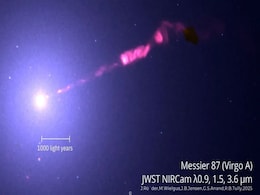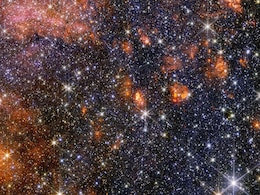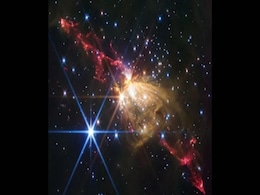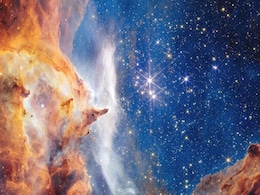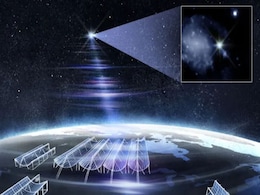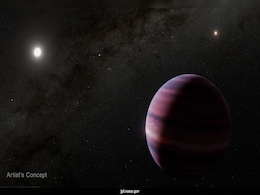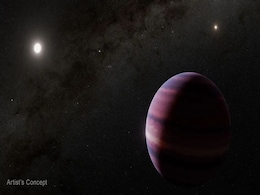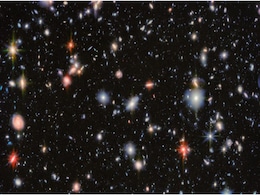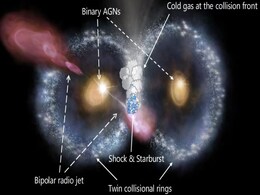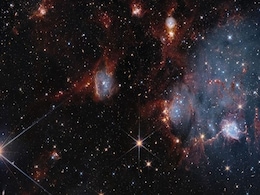Webb Image
- All
- News
- Videos
- Web Stories
-

"Cosmic Creepy-Crawly": NASA Shares Stunning New Details Of Red Spider Nebula
- Thursday November 27, 2025
- Science |
The image was captured by NIRCam, Webb's primary near-infrared imager, which aims to provide high-resolution imaging and spectroscopy.
-
 www.ndtv.com
www.ndtv.com
-

Webb’s Stunning View of Apep Shows a Rare Triple-Star System Wrapped in Spirals
- Sunday November 23, 2025
Webb’s mid-infrared images of Apep reveal a rare triple-star system producing vast carbon-rich dust spirals from colliding stellar winds. The two Wolf–Rayet stars and a distant supergiant create layered shells that record centuries of activity and enrich the galaxy with elements vital for future stars and planets.
-
 www.gadgets360.com
www.gadgets360.com
-

Harvard Scientist Questions NASA Images Of 3I/ATLAS: "Nothing More Deceptive Than Obvious Fact"
- Thursday November 20, 2025
- Science |
Avi Loeb claimed that images taken by amateur astronomers were "far more exciting than the HiRISE image shared by NASA".
-
 www.ndtv.com
www.ndtv.com
-

NASA’s JWST Produces First-Ever 3D Map of Distant Planet WASP-18b
- Monday November 3, 2025
NASA’s James Webb Space Telescope has created the first-ever 3D atmospheric map of an exoplanet, revealing the extreme conditions on WASP-18b, an “ultra-hot Jupiter” located 400 light-years away. Using infrared eclipse mapping, scientists discovered a scorching hotspot over 2,700 °C where water molecules are breaking apart. This groundbreaki...
-
 www.gadgets360.com
www.gadgets360.com
-

JWST Reveals Stunning New Details About M87’s Supermassive Black Hole Jet
- Saturday October 4, 2025
Recent images captured by the James Webb Space Telescope (JWST) are the clearest ever pictures of the jet arriving from the massive black hole in the galaxy named Messier 87 (M87). There are clear details in the image shot by the telescope, which show the change of brightness, shape and the jet that is usually in disguise. As per scientists, this d...
-
 www.gadgets360.com
www.gadgets360.com
-

James Webb Telescope Unveils Hidden Star-Forming Regions in Sagittarius B2
- Wednesday October 1, 2025
New JWST observations reveal the hidden star-forming activity inside Sagittarius B2, the Milky Way’s largest molecular cloud. By seeing through dense dust, astronomers can study how stars form efficiently in extreme environments. These findings help explain not only Sgr B2 but also broader mechanisms shaping galaxies.
-
 www.gadgets360.com
www.gadgets360.com
-

James Webb Space Telescope Spots Rare Protostar Blasting Twin Jets Across Milky Way
- Friday September 12, 2025
NASA’s James Webb Space Telescope has captured a rare protostar about ten times the Sun’s mass blasting twin jets nearly eight light-years long. The beams carve through the glowing Sharpless 2-284 nebula, offering astronomers a vivid glimpse into how massive stars form and shape their galactic environment.
-
 www.gadgets360.com
www.gadgets360.com
-

NASA's James Webb Space Telescope Captures Lobster Nebula’s Towering Spires and Massive Stars
- Monday September 8, 2025
NASA’s Webb Telescope imaged the Lobster Nebula (NGC 6357), 5,500 light-years away. Its young star cluster, Pismis 24, contains giant stars carving glowing gas pillars. Pismis 24-1, once thought to be one supermassive star, is a triple system with stars up to 74 times the Sun’s mass.
-
 www.gadgets360.com
www.gadgets360.com
-

Astronomers Detect RBFLOAT, Brightest Fast Radio Burst Ever Observed
- Monday August 25, 2025
An international team of astronomers has detected RBFLOAT, the brightest fast radio burst (FRB) ever recorded, just 130 million light-years away in Ursa Major. Detected by CHIME in March 2025, the powerful radio flash was traced to galaxy NGC-4141. Follow-up imaging with the James Webb Space Telescope revealed a faint stellar source near the burst,...
-
 www.gadgets360.com
www.gadgets360.com
-

A New 'Earth' Next Door? Scientists Detect Possible Habitable Planet Around Closest Sun-Like Star
- Friday August 15, 2025
- Science |
Astronomers using JWST have detected a giant exoplanet in the habitable zone of Alpha Centauri A, our nearest Sun-like star.
-
 www.ndtv.com
www.ndtv.com
-

James Webb Telescope Detects Potential Gas Giant Exoplanet Just 4 Light-Years Away
- Friday August 8, 2025
Astronomers using JWST have spotted a possible gas giant orbiting Alpha Centauri A, only 4 light-years away. If confirmed, it would be the closest exoplanet to a Sun-like star ever imaged. The discovery could challenge current models of planetary formation in binary systems and open new opportunities for studying nearby worlds.
-
 www.gadgets360.com
www.gadgets360.com
-

James Webb Space Telescope Reimagines Hubble’s Deep Field, Unveils Ancient Galaxies
- Tuesday August 5, 2025
The James Webb Space Telescope has re-imaged part of Hubble’s Ultra Deep Field, revealing over 2,500 galaxies in stunning infrared detail. Using its NIRCam and MIRI instruments, Webb observed faint galaxies dating back to just a few hundred million years after the Big Bang. This is part of the JADES survey, which includes the deepest mid-infrared...
-
 www.gadgets360.com
www.gadgets360.com
-

James Webb Telescope Spots Rare ‘Cosmic Owl’ Formed by Colliding Galaxies
- Monday July 14, 2025
NASA’s James Webb Space Telescope has unveiled the “Cosmic Owl,” a jaw-dropping image of two colliding ring galaxies forming a structure that resembles an owl’s face. This double-ring formation is extraordinarily rare, and the event is shedding light on galaxy evolution, black hole dynamics, and rapid star formation. Led by Ph.D. student Mi...
-
 www.gadgets360.com
www.gadgets360.com
-

NASA’s Hubble and Webb Discover Bursting Star Formation in Small Magellanic Cloud
- Saturday July 12, 2025
NASA’s Hubble and Webb telescopes have captured spectacular images of NGC 460 and NGC 456, two star clusters in the Small Magellanic Cloud. These young, open clusters are filled with massive, hot stars that trigger new star formation by carving nebulae. The findings provide insights into early universe conditions and interstellar medium behaviour...
-
 www.gadgets360.com
www.gadgets360.com
-

"Cosmic Creepy-Crawly": NASA Shares Stunning New Details Of Red Spider Nebula
- Thursday November 27, 2025
- Science |
The image was captured by NIRCam, Webb's primary near-infrared imager, which aims to provide high-resolution imaging and spectroscopy.
-
 www.ndtv.com
www.ndtv.com
-

Webb’s Stunning View of Apep Shows a Rare Triple-Star System Wrapped in Spirals
- Sunday November 23, 2025
Webb’s mid-infrared images of Apep reveal a rare triple-star system producing vast carbon-rich dust spirals from colliding stellar winds. The two Wolf–Rayet stars and a distant supergiant create layered shells that record centuries of activity and enrich the galaxy with elements vital for future stars and planets.
-
 www.gadgets360.com
www.gadgets360.com
-

Harvard Scientist Questions NASA Images Of 3I/ATLAS: "Nothing More Deceptive Than Obvious Fact"
- Thursday November 20, 2025
- Science |
Avi Loeb claimed that images taken by amateur astronomers were "far more exciting than the HiRISE image shared by NASA".
-
 www.ndtv.com
www.ndtv.com
-

NASA’s JWST Produces First-Ever 3D Map of Distant Planet WASP-18b
- Monday November 3, 2025
NASA’s James Webb Space Telescope has created the first-ever 3D atmospheric map of an exoplanet, revealing the extreme conditions on WASP-18b, an “ultra-hot Jupiter” located 400 light-years away. Using infrared eclipse mapping, scientists discovered a scorching hotspot over 2,700 °C where water molecules are breaking apart. This groundbreaki...
-
 www.gadgets360.com
www.gadgets360.com
-

JWST Reveals Stunning New Details About M87’s Supermassive Black Hole Jet
- Saturday October 4, 2025
Recent images captured by the James Webb Space Telescope (JWST) are the clearest ever pictures of the jet arriving from the massive black hole in the galaxy named Messier 87 (M87). There are clear details in the image shot by the telescope, which show the change of brightness, shape and the jet that is usually in disguise. As per scientists, this d...
-
 www.gadgets360.com
www.gadgets360.com
-

James Webb Telescope Unveils Hidden Star-Forming Regions in Sagittarius B2
- Wednesday October 1, 2025
New JWST observations reveal the hidden star-forming activity inside Sagittarius B2, the Milky Way’s largest molecular cloud. By seeing through dense dust, astronomers can study how stars form efficiently in extreme environments. These findings help explain not only Sgr B2 but also broader mechanisms shaping galaxies.
-
 www.gadgets360.com
www.gadgets360.com
-

James Webb Space Telescope Spots Rare Protostar Blasting Twin Jets Across Milky Way
- Friday September 12, 2025
NASA’s James Webb Space Telescope has captured a rare protostar about ten times the Sun’s mass blasting twin jets nearly eight light-years long. The beams carve through the glowing Sharpless 2-284 nebula, offering astronomers a vivid glimpse into how massive stars form and shape their galactic environment.
-
 www.gadgets360.com
www.gadgets360.com
-

NASA's James Webb Space Telescope Captures Lobster Nebula’s Towering Spires and Massive Stars
- Monday September 8, 2025
NASA’s Webb Telescope imaged the Lobster Nebula (NGC 6357), 5,500 light-years away. Its young star cluster, Pismis 24, contains giant stars carving glowing gas pillars. Pismis 24-1, once thought to be one supermassive star, is a triple system with stars up to 74 times the Sun’s mass.
-
 www.gadgets360.com
www.gadgets360.com
-

Astronomers Detect RBFLOAT, Brightest Fast Radio Burst Ever Observed
- Monday August 25, 2025
An international team of astronomers has detected RBFLOAT, the brightest fast radio burst (FRB) ever recorded, just 130 million light-years away in Ursa Major. Detected by CHIME in March 2025, the powerful radio flash was traced to galaxy NGC-4141. Follow-up imaging with the James Webb Space Telescope revealed a faint stellar source near the burst,...
-
 www.gadgets360.com
www.gadgets360.com
-

A New 'Earth' Next Door? Scientists Detect Possible Habitable Planet Around Closest Sun-Like Star
- Friday August 15, 2025
- Science |
Astronomers using JWST have detected a giant exoplanet in the habitable zone of Alpha Centauri A, our nearest Sun-like star.
-
 www.ndtv.com
www.ndtv.com
-

James Webb Telescope Detects Potential Gas Giant Exoplanet Just 4 Light-Years Away
- Friday August 8, 2025
Astronomers using JWST have spotted a possible gas giant orbiting Alpha Centauri A, only 4 light-years away. If confirmed, it would be the closest exoplanet to a Sun-like star ever imaged. The discovery could challenge current models of planetary formation in binary systems and open new opportunities for studying nearby worlds.
-
 www.gadgets360.com
www.gadgets360.com
-

James Webb Space Telescope Reimagines Hubble’s Deep Field, Unveils Ancient Galaxies
- Tuesday August 5, 2025
The James Webb Space Telescope has re-imaged part of Hubble’s Ultra Deep Field, revealing over 2,500 galaxies in stunning infrared detail. Using its NIRCam and MIRI instruments, Webb observed faint galaxies dating back to just a few hundred million years after the Big Bang. This is part of the JADES survey, which includes the deepest mid-infrared...
-
 www.gadgets360.com
www.gadgets360.com
-

James Webb Telescope Spots Rare ‘Cosmic Owl’ Formed by Colliding Galaxies
- Monday July 14, 2025
NASA’s James Webb Space Telescope has unveiled the “Cosmic Owl,” a jaw-dropping image of two colliding ring galaxies forming a structure that resembles an owl’s face. This double-ring formation is extraordinarily rare, and the event is shedding light on galaxy evolution, black hole dynamics, and rapid star formation. Led by Ph.D. student Mi...
-
 www.gadgets360.com
www.gadgets360.com
-

NASA’s Hubble and Webb Discover Bursting Star Formation in Small Magellanic Cloud
- Saturday July 12, 2025
NASA’s Hubble and Webb telescopes have captured spectacular images of NGC 460 and NGC 456, two star clusters in the Small Magellanic Cloud. These young, open clusters are filled with massive, hot stars that trigger new star formation by carving nebulae. The findings provide insights into early universe conditions and interstellar medium behaviour...
-
 www.gadgets360.com
www.gadgets360.com






